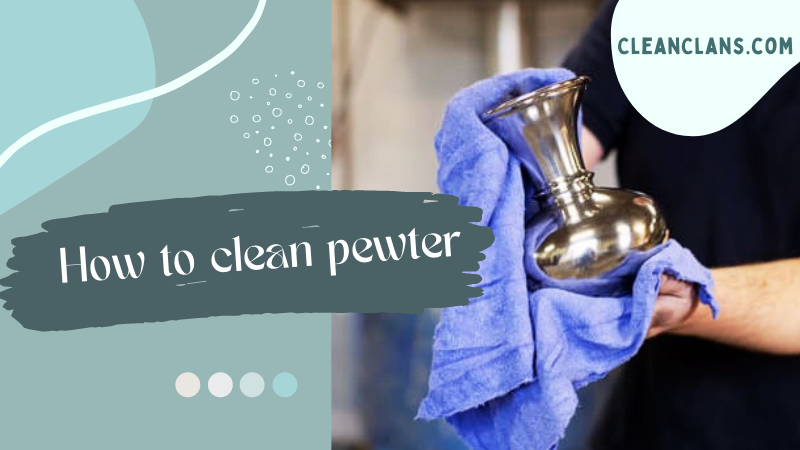Pewter is a beautiful metal that can add a touch of elegance to any home. However, like all metals, pewter can tarnish over time. If you want to keep your pewter looking its best, it’s important to clean it regularly. Here are a few tips on how to clean pewter.

Table of Contents
What is pewter?
Pewter is a metal that is made mostly of tin. It also contains small amounts of copper and antimony. Pewter has been used to make things like plates, bowls, and jewelry for centuries.
Why does pewter tarnish?
Pewter tarnishes because of the chemicals in the air. When these chemicals come into contact with the metal, they cause it to oxidize. This process is what turns the metal from a shiny silver color to a dull gray.
How to clean pewter
There are several ways to clean pewter. You can use commercial metal polish or make your cleaning solution with vinegar and water.
Clean the pewter with a commercial metal polish according to the directions on the label. To prepare your cleaning solution, combine equal amounts of vinegar and water in a bowl. Wipe down the pewter using a soft cloth soaked in the mixture. Rinse the pewter with clean water and then dry it off with a fresh cloth
Tips for maintaining pewter
To preserve the color and condition of your pewter, there are a few things you can do. First, avoid using abrasive chemicals or harsh cleansers on the metal. Second, keep the pewter in a cool, dry location. Finally, polish the pewter regularly to keep it gleaming.

How to clean different types of pewter home appliances
Pewter is a soft, malleable metal that can be easily damaged if not cleaned and cared for properly. To clean different types of pewter home appliances, follow these simple steps:
Pewter Jewelry
To clean pewter jewelry:
- Mix one-part dish soap with two parts water in a bowl.
- Use a soft toothbrush to gently scrub the pewter jewelry clean.
- Rinse the jewelry well with warm water and dry it thoroughly with a soft cloth. If your pewter jewelry is still tarnished, you can use a commercial pewter polish or a paste made from equal parts salt, flour, and vinegar.
- Rub the paste onto the jewelry with a soft cloth and then rinse it clean with warm water.
- Dry the jewelry thoroughly before storing it.
Pewter Dishes
Pewter dishes can be cleaned with mild dish soap and water. Be sure to rinse them thoroughly and dry them completely before storing them. If your pewter dishes are heavily tarnished, you can use a paste made of baking soda and water to clean them. Just be sure to rinse them well afterward and dry them completely.
Pewter Metal
You can use a soft cloth and soapy water to wipe away dirt or grime. You can also use a toothbrush to reach small crevices and scrub away any build-up. If your pewter is particularly dirty, you may need to use a metal polish to get it sparkling clean. Follow the directions on the metal polish to avoid damaging the pewter. Once you’ve cleaned the pewter, dry it completely to prevent water spots.
Cleaning Pewter Naturally
Pewter is a malleable metal alloy traditionally made up of 85-99% tin, with the addition of copper, antimony, and sometimes bismuth. Pewter has a long history dating back to the Bronze Age and was used for many different purposes, including making coins, jewelry, utensils, and other objects.
Pewter can develop a dark patina over time, but it is easy to clean and polish at home. Here are a few simple tips on how to clean pewter naturally:
– Start by mixing equal parts of water and vinegar in a bowl.
– Dip a soft cloth into the mixture and use it to wipe down the pewter surface.
– Rinse the pewter with clean water and dry it with a soft cloth.
– For more stubborn tarnish, you can try using a commercial pewter polish or cleaner. But, again, follow the instructions on the product label.
With a little bit of elbow grease, you should be able to clean your pewter and restore it to its original luster. So enjoy your newly polished pewter!
Pewter Mugs
Pewter mugs can be cleaned using many different methods. One popular method is to use white vinegar and water. Simply mix equal parts of each in a bowl and then use a clean cloth to wipe down the mug. Another option is to use a mild detergent and water. Again, mix equal parts in a bowl and then use a clean cloth to wipe down the mug. If you have stubborn stains, you can try using a soft-bristled brush and mild soap. Gently scrub the affected area and then rinse with clean water. You can also use a commercial pewter cleaner, following the instructions on the product label. Whichever method you choose, rinse the mug well with clean water and dry it thoroughly before using it.
Oxidized Pewter
Oxidation is a natural process that happens when the metal comes into contact with the air. It’s what causes silverware to get those brownish-black stains over time. The good news is that it’s easy to remove the oxidation from the pewter by using a gentle cleaner like soap and water. You can also try rubbing it down with some vinegar.
Pewter Figurines
To clean pewter figurines, you will need a mild soap or detergent, a soft cloth, and some lukewarm water. First, gently dust the figurine with a soft cloth to remove loose dirt or debris. Next, mix a small amount of soap or detergent with lukewarm water. Next, using a soft cloth, carefully wipe down the figurine with soapy water. Avoid getting the water too hot, as this could damage the pewter. Finally, rinse the figurine off with clean water and dry it thoroughly with a soft cloth.
Pewter Teapot
If you’re wondering how to clean a pewter teapot, don’t worry – it’s not that difficult! Here are a few simple steps to get your teapot shining like new again:
- Rinse the teapot out with warm water to remove any loose dirt or debris.
- Fill the teapot with water and add a mild dishwashing soap. Let it soak for 10-15 minutes.
- Use a soft sponge or cloth to scrub the inside and outside of the teapot, paying special attention to any areas that seem particularly dirty or tarnished.
- Rinse the teapot well with warm water and dry it thoroughly with a soft cloth.
- If your teapot is still looking dull, you can try polishing it with a soft, dry cloth. You can also purchase special pewter polish from most hardware or home improvement stores.
Pewter Cup
Simple methods you can use. First, you can try simply wiping it down with a damp cloth. Then, if the cup is particularly dirty, you can scrub it with a soft brush and soapy water. You can also polish the cup with metal polish or olive oil to restore its shine.
Whichever method you choose, be sure to rinse the cup well and dry it afterward to prevent further tarnishing. Your pewter cup will stay clean and shiny for years to come with a little care!
Pewter Candlesticks
To clean pewter candlesticks, start by wiping them down with a dry cloth to remove any loose dirt or dust. Next, mix 1 teaspoon of baking soda and 1 tablespoon of vinegar in a small bowl. Next, dip a soft-bristled toothbrush into the baking soda and vinegar mixture and scrub the pewter candlesticks until they are clean. Finally, rinse the candlesticks with warm water and dry them with a towel.
Pewter Miniatures
Here are a few tips to help clean your pewter miniatures:
- Soak the miniatures in warm water with dish soap.
- Scrub the miniatures with a soft toothbrush.
- Rinse the miniatures with cool water.
- Dry the miniatures with a soft cloth.
Pewter Flask
If your pewter flask looks a bit dull, you can clean it up with just a few simple household materials. You’ll need some white vinegar, a soft cloth, and baking soda. First, mix equal parts of vinegar and water in a bowl. Then, dip your cloth into the mixture and use it to wipe down the flask. Next, sprinkle a bit of baking soda onto the wet cloth and scrub the flask. Finally, rinse the flask with water and dry it with a clean cloth. Your pewter flask will now be shining like new!
Conclusion how to clean pewter
Pewter is a lovely metal that may be used in any home to add a touch of class. Pewter, like all metals, will tarnish with time. It’s critical to clean the pewter regularly if you want it to look good. Cleaning pewter with commercial metal polish or a combination of vinegar and water


